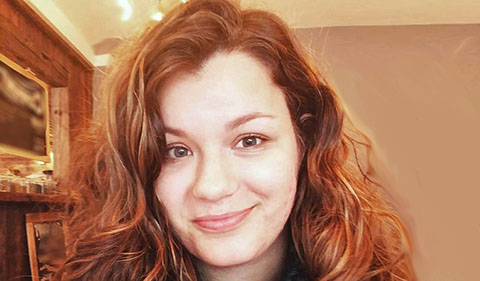
Morgan Olmstead
Editor’s Note: The Happy Beginnings series features recent College of Arts & Sciences graduates who are getting started in careers, graduate school and service.
Morgan Olmstead graduated in Spring 2016 with her B.S. in Biological Sciences and minor in Anthropology and a Certificate in Global Health from Ohio University.
The following fall she started at the University of New Hampshire’s Biological Sciences master’s program in Integrative Organismal Biology. Coming out of her senior year Olmstead knew she wanted to do research regarding insects and their microbiome, thanks to Introduction to Microbiology. She looked into a number of different graduate programs and found that Dr. Carrie Hall was starting exciting research regarding insects with interesting life histories and involvement with bacteria and fungi.
Charismatic Burying Beetles
“The insect I work with is a group of beetles commonly referred to as burying beetles,” Olmstead explains. “They are very charismatic organisms with an interesting life history of finding small vertebrate carrion (mice and birds) and burying them underground to protect from other scavengers. They begin by finding the carrion in either woods or a prairie and bury it within a few hours, removing the fur or feathers all while secreting antibactierial and antifungal liquids over the animal. The female lays her eggs to the side underground and the larvae find their way to the carrion resource. These beetles are of special interest to entomologists as they exhibit biparental care, meaning both the female and the male care for the larvae by directly feeding them over a period of time.”
Olmstead’s project involves looking at how their microbiome affects their reproductive behavior. They have several steps within this reproductive process that follow a timeline and certain known behaviors; however, there is current research in entomology that indicate that microbes may influence insect behavior.
She is doing a lot of dissections, DNA extractions, and microbial ecology bioinformatics work to characterize their microbiome and look for differences within the genus based on certain criteria.
The Best Part
What Olmstead loves most about what she does is problem solving an experiment that is not working.
“I hate that it may not be going the way I expect,” she explains, “but managing to find a solution for it is always exciting and worth the struggle.”
Always Learning
Completing the global health certificate and capstone project were very helpful in understanding how much work goes into a research project. Also, Olmstead believes that exploring classes that may not have been necessary for her to graduate, but interesting in her major really helped her discover what she enjoyed.
She is glad she took advantage of an opportunity to work in Dr. Kelly Johnson’s lab, but wishes she had known as an undergraduate how much she would enjoy lab related research and how important doing undergraduate research was.
Now Olmstead is working on determining an antibiotic treatment for the insects so she can begin breeding experiments with two species, one being the endangered American burying beetle (from the prairies of Oklahoma).
“Going on to grad school directly after graduating was the right decision for me because I was unsure of what I wanted to do after graduation and wanted to pursue a small interest in research.”
She expects to graduate in the spring and to continue learning new and exciting science in whatever she pursues next!



















Comments